Tourism and Hospitality Management: Redefining Tourism in Singapore
VerifiedAdded on 2023/06/12
|36
|10566
|97
Report
AI Summary
This report provides an analysis of tourism and hospitality management, with a specific focus on Singapore's economic development. It redefines tourism by encompassing its broader impact on the country and proposes reformulating tourism products to create lasting impressions. The report emphasizes developing tourism as a key industry due to its significant economic contributions. It also explores configuring new tourism spaces through regionalization strategies, fostering collaboration, and championing tourism initiatives. The analysis considers factors such as Singapore's society, culture, environment, technology, politics, and economy, as well as key components like destinations, attractions, transportation, accommodation, and food services. The report highlights the importance of a qualified workforce and the use of technology to drive quality growth in Singapore's tourism sector, aiming to enhance its global appeal and economic stability. The report concludes by emphasizing the need for continuous improvement and strategic partnerships to ensure the long-term success of Singapore's tourism industry.
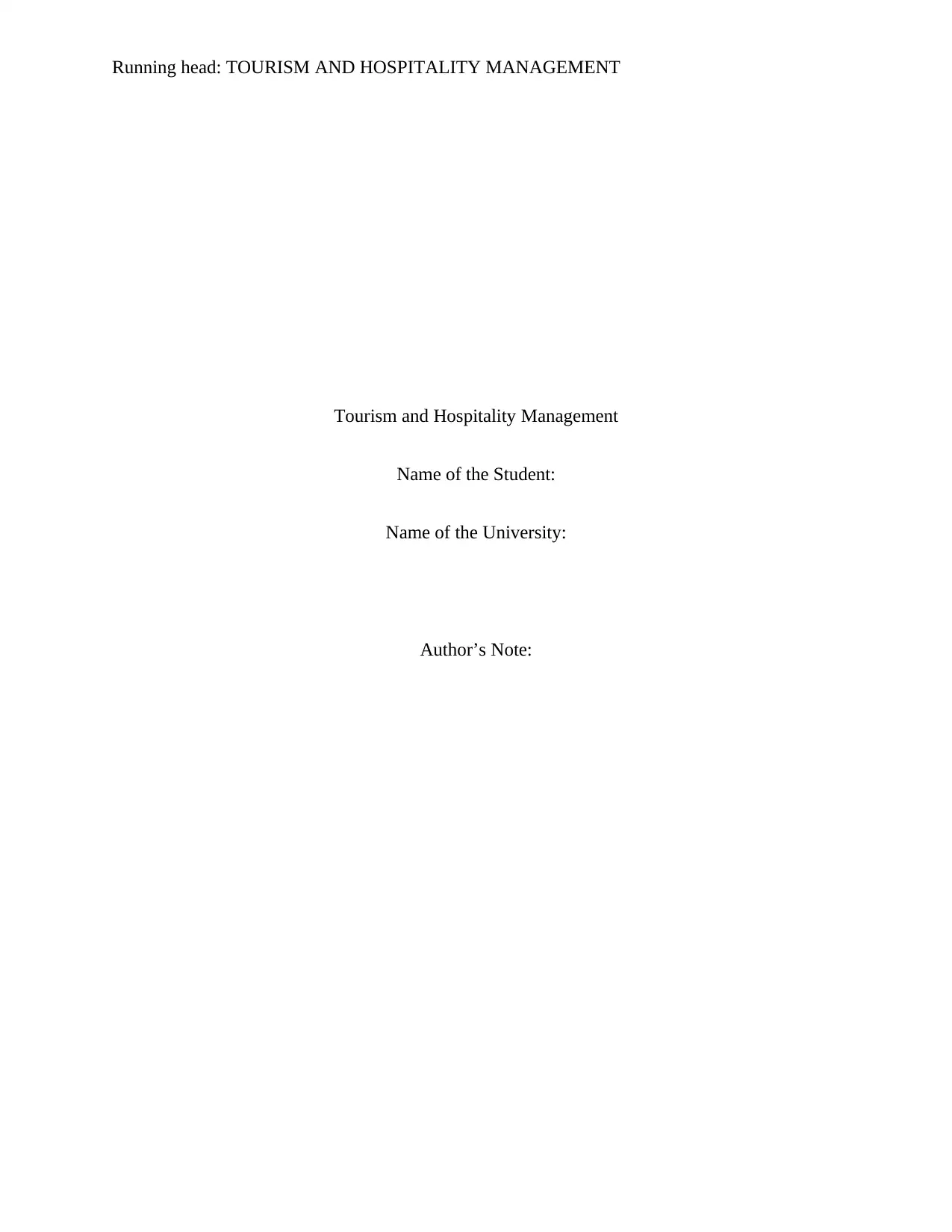
Running head: TOURISM AND HOSPITALITY MANAGEMENT
Tourism and Hospitality Management
Name of the Student:
Name of the University:
Author’s Note:
Tourism and Hospitality Management
Name of the Student:
Name of the University:
Author’s Note:
Paraphrase This Document
Need a fresh take? Get an instant paraphrase of this document with our AI Paraphraser
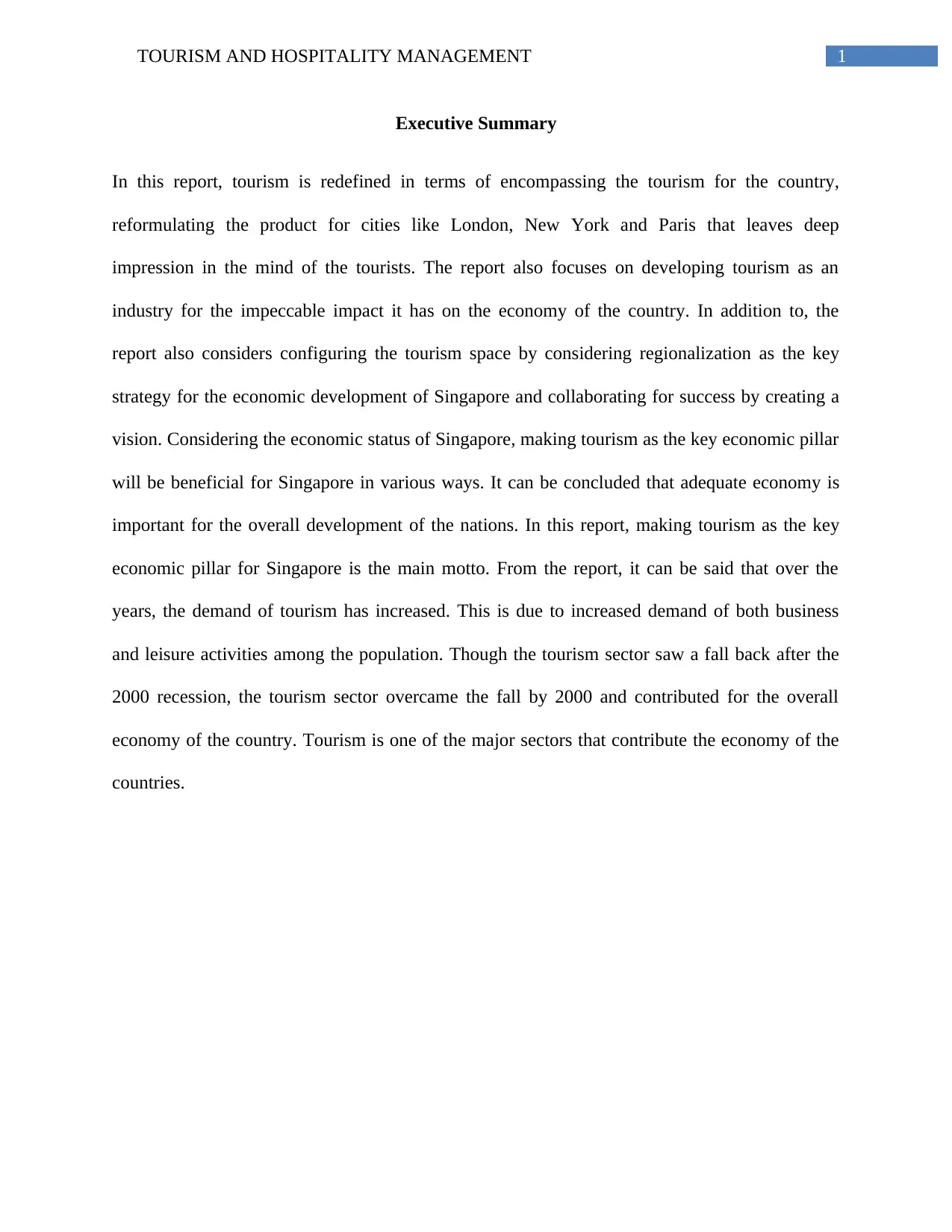
1TOURISM AND HOSPITALITY MANAGEMENT
Executive Summary
In this report, tourism is redefined in terms of encompassing the tourism for the country,
reformulating the product for cities like London, New York and Paris that leaves deep
impression in the mind of the tourists. The report also focuses on developing tourism as an
industry for the impeccable impact it has on the economy of the country. In addition to, the
report also considers configuring the tourism space by considering regionalization as the key
strategy for the economic development of Singapore and collaborating for success by creating a
vision. Considering the economic status of Singapore, making tourism as the key economic pillar
will be beneficial for Singapore in various ways. It can be concluded that adequate economy is
important for the overall development of the nations. In this report, making tourism as the key
economic pillar for Singapore is the main motto. From the report, it can be said that over the
years, the demand of tourism has increased. This is due to increased demand of both business
and leisure activities among the population. Though the tourism sector saw a fall back after the
2000 recession, the tourism sector overcame the fall by 2000 and contributed for the overall
economy of the country. Tourism is one of the major sectors that contribute the economy of the
countries.
Executive Summary
In this report, tourism is redefined in terms of encompassing the tourism for the country,
reformulating the product for cities like London, New York and Paris that leaves deep
impression in the mind of the tourists. The report also focuses on developing tourism as an
industry for the impeccable impact it has on the economy of the country. In addition to, the
report also considers configuring the tourism space by considering regionalization as the key
strategy for the economic development of Singapore and collaborating for success by creating a
vision. Considering the economic status of Singapore, making tourism as the key economic pillar
will be beneficial for Singapore in various ways. It can be concluded that adequate economy is
important for the overall development of the nations. In this report, making tourism as the key
economic pillar for Singapore is the main motto. From the report, it can be said that over the
years, the demand of tourism has increased. This is due to increased demand of both business
and leisure activities among the population. Though the tourism sector saw a fall back after the
2000 recession, the tourism sector overcame the fall by 2000 and contributed for the overall
economy of the country. Tourism is one of the major sectors that contribute the economy of the
countries.
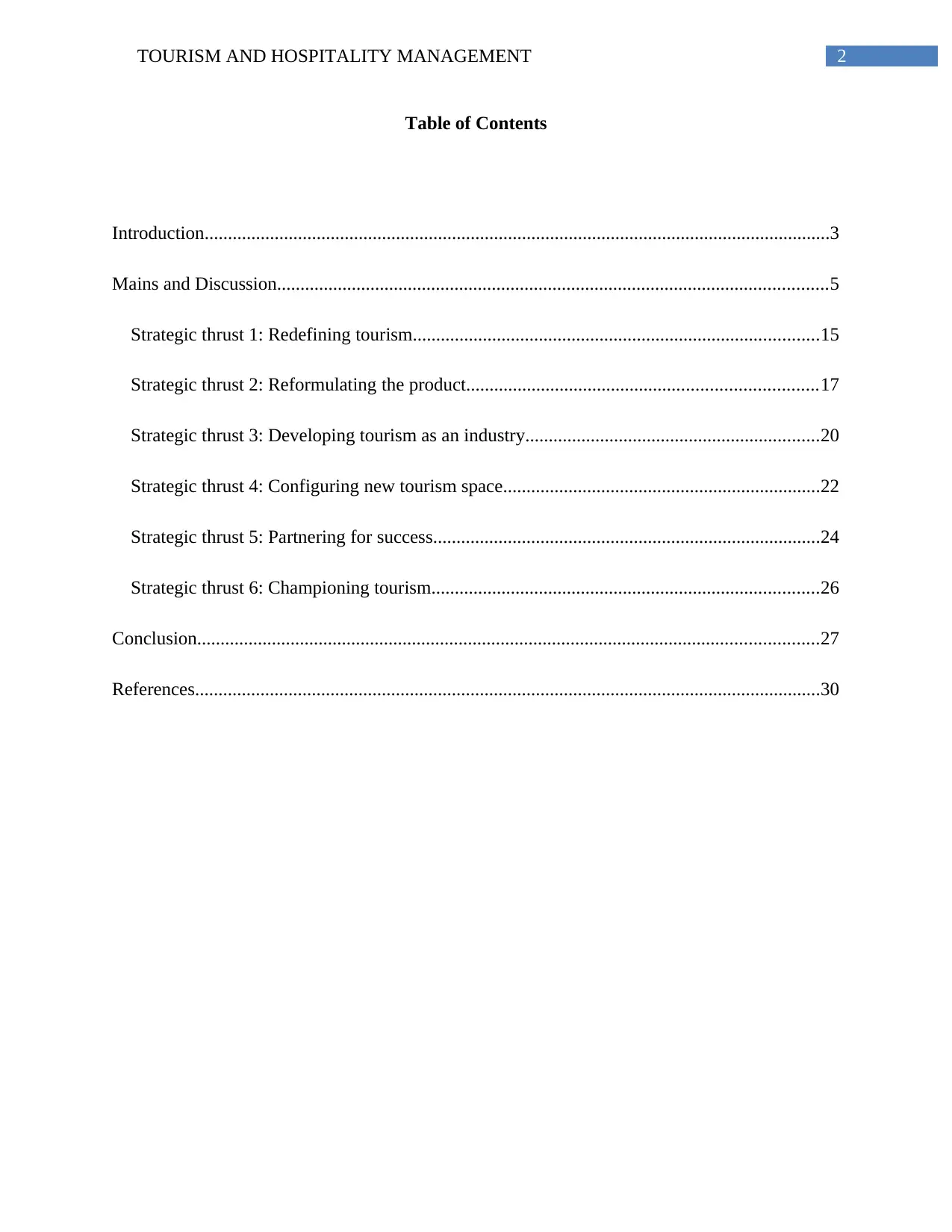
2TOURISM AND HOSPITALITY MANAGEMENT
Table of Contents
Introduction......................................................................................................................................3
Mains and Discussion......................................................................................................................5
Strategic thrust 1: Redefining tourism.......................................................................................15
Strategic thrust 2: Reformulating the product...........................................................................17
Strategic thrust 3: Developing tourism as an industry...............................................................20
Strategic thrust 4: Configuring new tourism space....................................................................22
Strategic thrust 5: Partnering for success...................................................................................24
Strategic thrust 6: Championing tourism...................................................................................26
Conclusion.....................................................................................................................................27
References......................................................................................................................................30
Table of Contents
Introduction......................................................................................................................................3
Mains and Discussion......................................................................................................................5
Strategic thrust 1: Redefining tourism.......................................................................................15
Strategic thrust 2: Reformulating the product...........................................................................17
Strategic thrust 3: Developing tourism as an industry...............................................................20
Strategic thrust 4: Configuring new tourism space....................................................................22
Strategic thrust 5: Partnering for success...................................................................................24
Strategic thrust 6: Championing tourism...................................................................................26
Conclusion.....................................................................................................................................27
References......................................................................................................................................30
⊘ This is a preview!⊘
Do you want full access?
Subscribe today to unlock all pages.

Trusted by 1+ million students worldwide
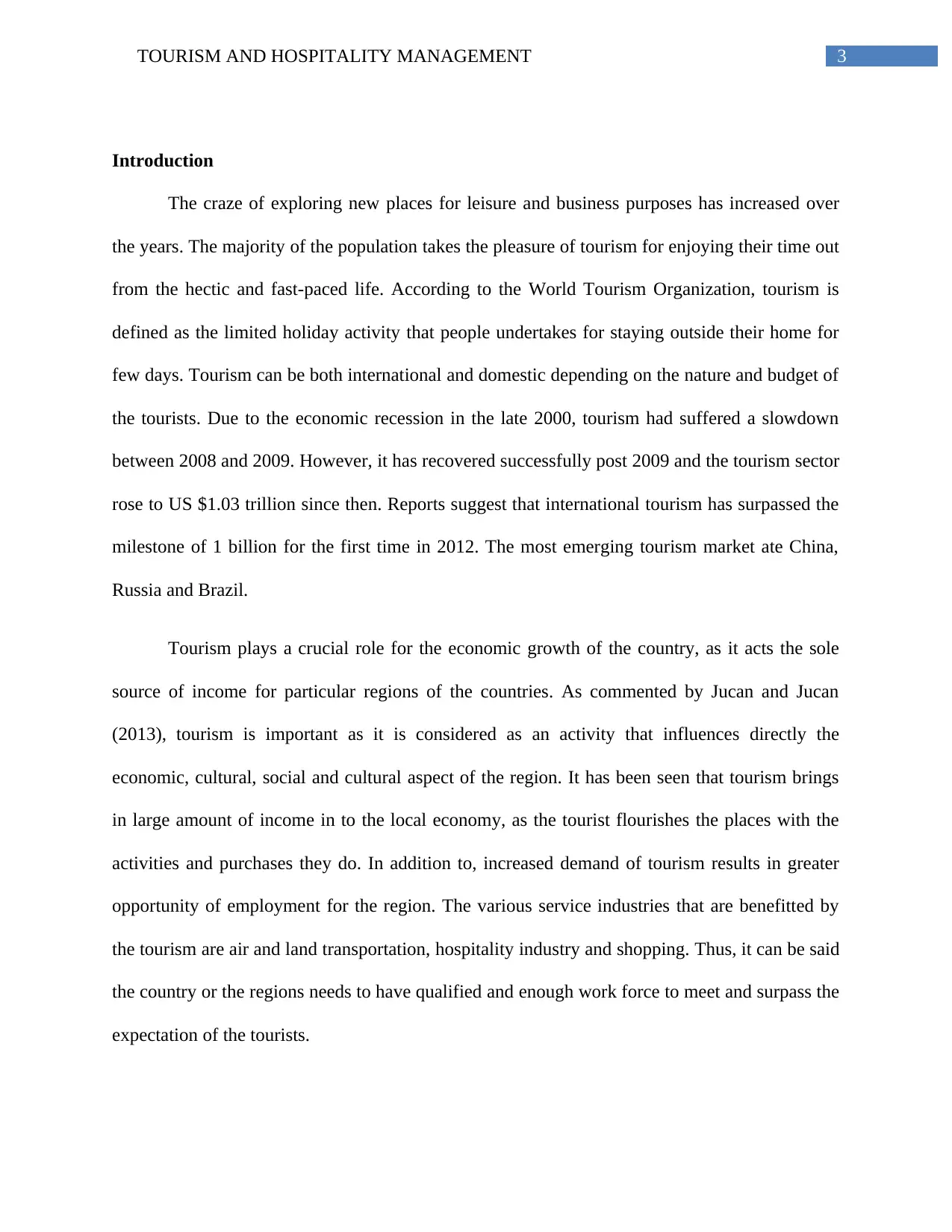
3TOURISM AND HOSPITALITY MANAGEMENT
Introduction
The craze of exploring new places for leisure and business purposes has increased over
the years. The majority of the population takes the pleasure of tourism for enjoying their time out
from the hectic and fast-paced life. According to the World Tourism Organization, tourism is
defined as the limited holiday activity that people undertakes for staying outside their home for
few days. Tourism can be both international and domestic depending on the nature and budget of
the tourists. Due to the economic recession in the late 2000, tourism had suffered a slowdown
between 2008 and 2009. However, it has recovered successfully post 2009 and the tourism sector
rose to US $1.03 trillion since then. Reports suggest that international tourism has surpassed the
milestone of 1 billion for the first time in 2012. The most emerging tourism market ate China,
Russia and Brazil.
Tourism plays a crucial role for the economic growth of the country, as it acts the sole
source of income for particular regions of the countries. As commented by Jucan and Jucan
(2013), tourism is important as it is considered as an activity that influences directly the
economic, cultural, social and cultural aspect of the region. It has been seen that tourism brings
in large amount of income in to the local economy, as the tourist flourishes the places with the
activities and purchases they do. In addition to, increased demand of tourism results in greater
opportunity of employment for the region. The various service industries that are benefitted by
the tourism are air and land transportation, hospitality industry and shopping. Thus, it can be said
the country or the regions needs to have qualified and enough work force to meet and surpass the
expectation of the tourists.
Introduction
The craze of exploring new places for leisure and business purposes has increased over
the years. The majority of the population takes the pleasure of tourism for enjoying their time out
from the hectic and fast-paced life. According to the World Tourism Organization, tourism is
defined as the limited holiday activity that people undertakes for staying outside their home for
few days. Tourism can be both international and domestic depending on the nature and budget of
the tourists. Due to the economic recession in the late 2000, tourism had suffered a slowdown
between 2008 and 2009. However, it has recovered successfully post 2009 and the tourism sector
rose to US $1.03 trillion since then. Reports suggest that international tourism has surpassed the
milestone of 1 billion for the first time in 2012. The most emerging tourism market ate China,
Russia and Brazil.
Tourism plays a crucial role for the economic growth of the country, as it acts the sole
source of income for particular regions of the countries. As commented by Jucan and Jucan
(2013), tourism is important as it is considered as an activity that influences directly the
economic, cultural, social and cultural aspect of the region. It has been seen that tourism brings
in large amount of income in to the local economy, as the tourist flourishes the places with the
activities and purchases they do. In addition to, increased demand of tourism results in greater
opportunity of employment for the region. The various service industries that are benefitted by
the tourism are air and land transportation, hospitality industry and shopping. Thus, it can be said
the country or the regions needs to have qualified and enough work force to meet and surpass the
expectation of the tourists.
Paraphrase This Document
Need a fresh take? Get an instant paraphrase of this document with our AI Paraphraser
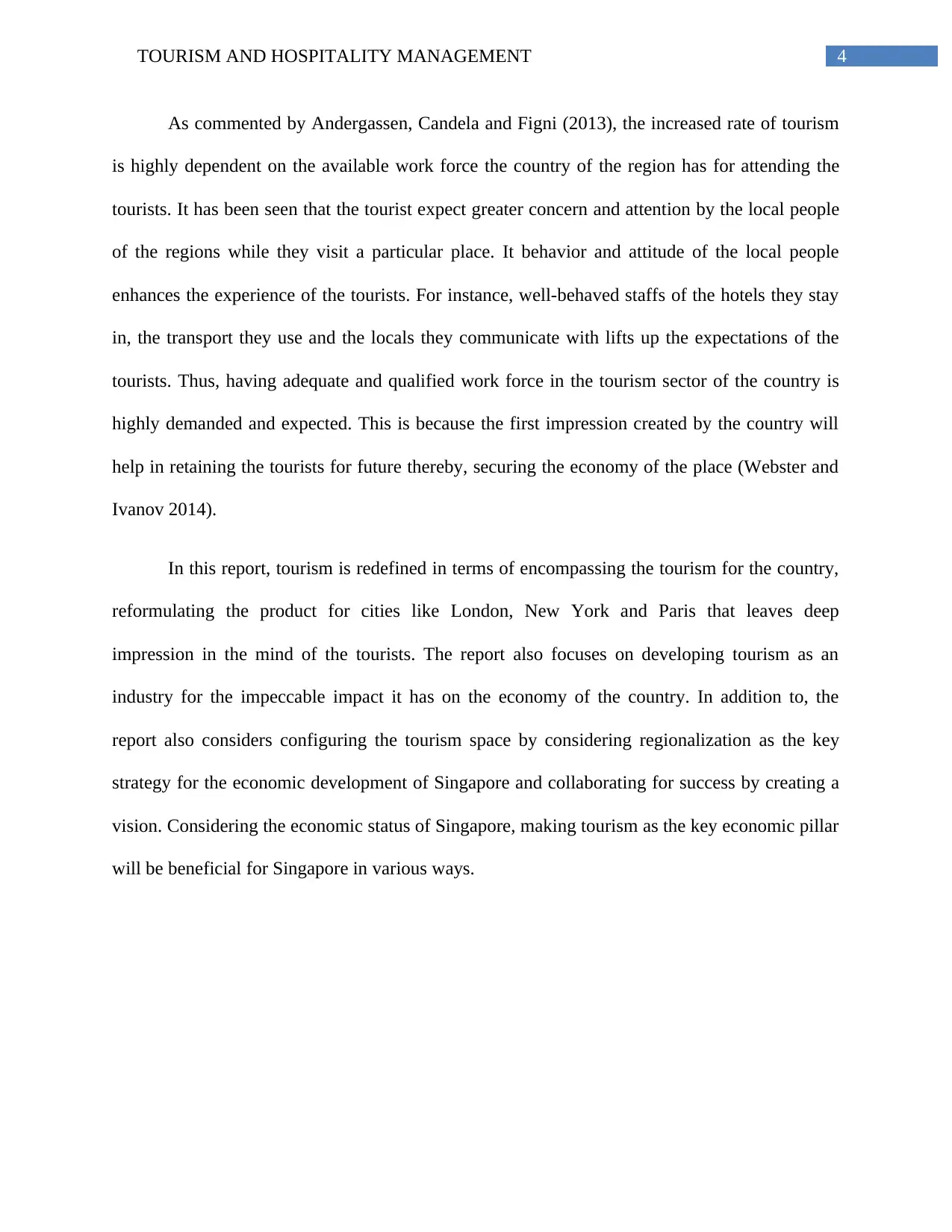
4TOURISM AND HOSPITALITY MANAGEMENT
As commented by Andergassen, Candela and Figni (2013), the increased rate of tourism
is highly dependent on the available work force the country of the region has for attending the
tourists. It has been seen that the tourist expect greater concern and attention by the local people
of the regions while they visit a particular place. It behavior and attitude of the local people
enhances the experience of the tourists. For instance, well-behaved staffs of the hotels they stay
in, the transport they use and the locals they communicate with lifts up the expectations of the
tourists. Thus, having adequate and qualified work force in the tourism sector of the country is
highly demanded and expected. This is because the first impression created by the country will
help in retaining the tourists for future thereby, securing the economy of the place (Webster and
Ivanov 2014).
In this report, tourism is redefined in terms of encompassing the tourism for the country,
reformulating the product for cities like London, New York and Paris that leaves deep
impression in the mind of the tourists. The report also focuses on developing tourism as an
industry for the impeccable impact it has on the economy of the country. In addition to, the
report also considers configuring the tourism space by considering regionalization as the key
strategy for the economic development of Singapore and collaborating for success by creating a
vision. Considering the economic status of Singapore, making tourism as the key economic pillar
will be beneficial for Singapore in various ways.
As commented by Andergassen, Candela and Figni (2013), the increased rate of tourism
is highly dependent on the available work force the country of the region has for attending the
tourists. It has been seen that the tourist expect greater concern and attention by the local people
of the regions while they visit a particular place. It behavior and attitude of the local people
enhances the experience of the tourists. For instance, well-behaved staffs of the hotels they stay
in, the transport they use and the locals they communicate with lifts up the expectations of the
tourists. Thus, having adequate and qualified work force in the tourism sector of the country is
highly demanded and expected. This is because the first impression created by the country will
help in retaining the tourists for future thereby, securing the economy of the place (Webster and
Ivanov 2014).
In this report, tourism is redefined in terms of encompassing the tourism for the country,
reformulating the product for cities like London, New York and Paris that leaves deep
impression in the mind of the tourists. The report also focuses on developing tourism as an
industry for the impeccable impact it has on the economy of the country. In addition to, the
report also considers configuring the tourism space by considering regionalization as the key
strategy for the economic development of Singapore and collaborating for success by creating a
vision. Considering the economic status of Singapore, making tourism as the key economic pillar
will be beneficial for Singapore in various ways.
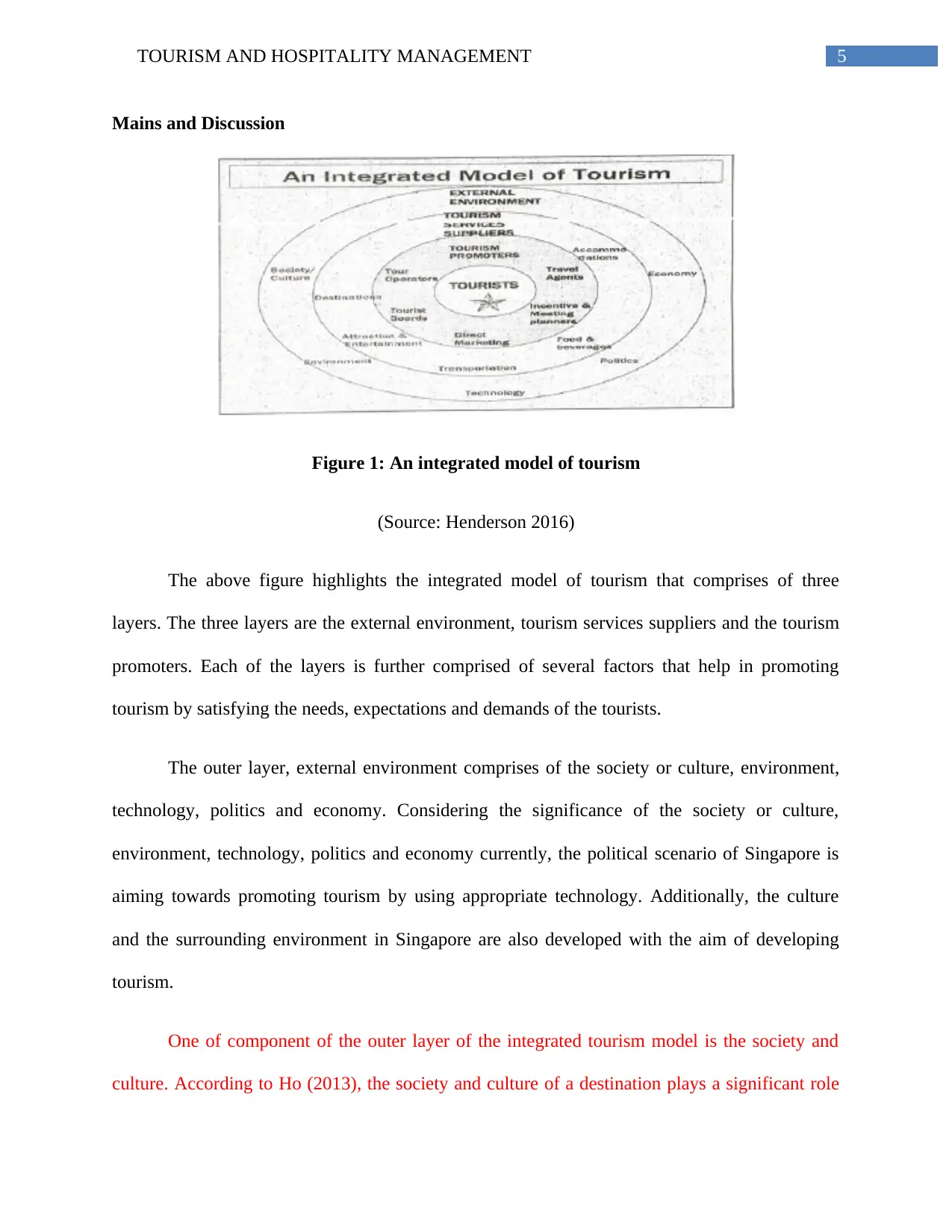
5TOURISM AND HOSPITALITY MANAGEMENT
Mains and Discussion
Figure 1: An integrated model of tourism
(Source: Henderson 2016)
The above figure highlights the integrated model of tourism that comprises of three
layers. The three layers are the external environment, tourism services suppliers and the tourism
promoters. Each of the layers is further comprised of several factors that help in promoting
tourism by satisfying the needs, expectations and demands of the tourists.
The outer layer, external environment comprises of the society or culture, environment,
technology, politics and economy. Considering the significance of the society or culture,
environment, technology, politics and economy currently, the political scenario of Singapore is
aiming towards promoting tourism by using appropriate technology. Additionally, the culture
and the surrounding environment in Singapore are also developed with the aim of developing
tourism.
One of component of the outer layer of the integrated tourism model is the society and
culture. According to Ho (2013), the society and culture of a destination plays a significant role
Mains and Discussion
Figure 1: An integrated model of tourism
(Source: Henderson 2016)
The above figure highlights the integrated model of tourism that comprises of three
layers. The three layers are the external environment, tourism services suppliers and the tourism
promoters. Each of the layers is further comprised of several factors that help in promoting
tourism by satisfying the needs, expectations and demands of the tourists.
The outer layer, external environment comprises of the society or culture, environment,
technology, politics and economy. Considering the significance of the society or culture,
environment, technology, politics and economy currently, the political scenario of Singapore is
aiming towards promoting tourism by using appropriate technology. Additionally, the culture
and the surrounding environment in Singapore are also developed with the aim of developing
tourism.
One of component of the outer layer of the integrated tourism model is the society and
culture. According to Ho (2013), the society and culture of a destination plays a significant role
⊘ This is a preview!⊘
Do you want full access?
Subscribe today to unlock all pages.

Trusted by 1+ million students worldwide
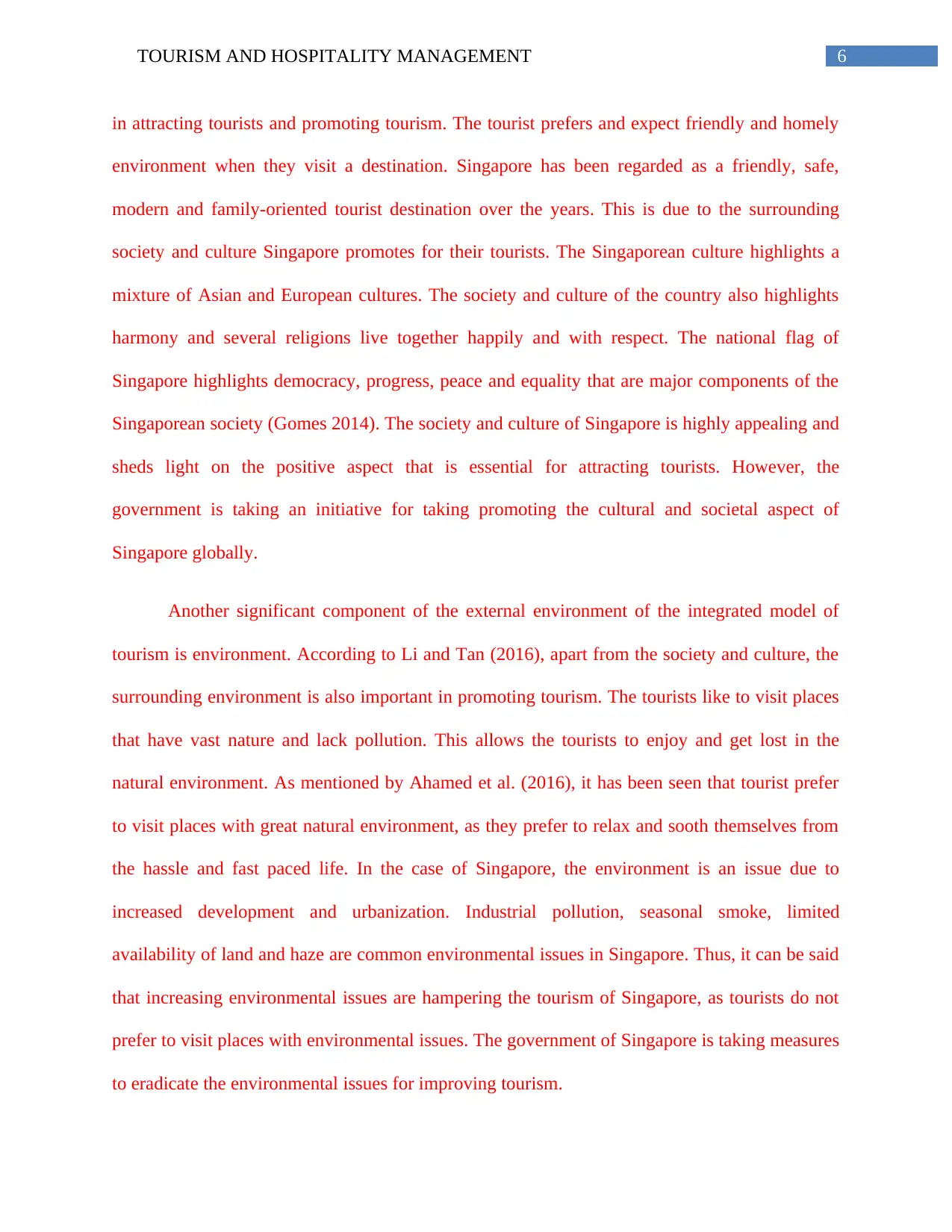
6TOURISM AND HOSPITALITY MANAGEMENT
in attracting tourists and promoting tourism. The tourist prefers and expect friendly and homely
environment when they visit a destination. Singapore has been regarded as a friendly, safe,
modern and family-oriented tourist destination over the years. This is due to the surrounding
society and culture Singapore promotes for their tourists. The Singaporean culture highlights a
mixture of Asian and European cultures. The society and culture of the country also highlights
harmony and several religions live together happily and with respect. The national flag of
Singapore highlights democracy, progress, peace and equality that are major components of the
Singaporean society (Gomes 2014). The society and culture of Singapore is highly appealing and
sheds light on the positive aspect that is essential for attracting tourists. However, the
government is taking an initiative for taking promoting the cultural and societal aspect of
Singapore globally.
Another significant component of the external environment of the integrated model of
tourism is environment. According to Li and Tan (2016), apart from the society and culture, the
surrounding environment is also important in promoting tourism. The tourists like to visit places
that have vast nature and lack pollution. This allows the tourists to enjoy and get lost in the
natural environment. As mentioned by Ahamed et al. (2016), it has been seen that tourist prefer
to visit places with great natural environment, as they prefer to relax and sooth themselves from
the hassle and fast paced life. In the case of Singapore, the environment is an issue due to
increased development and urbanization. Industrial pollution, seasonal smoke, limited
availability of land and haze are common environmental issues in Singapore. Thus, it can be said
that increasing environmental issues are hampering the tourism of Singapore, as tourists do not
prefer to visit places with environmental issues. The government of Singapore is taking measures
to eradicate the environmental issues for improving tourism.
in attracting tourists and promoting tourism. The tourist prefers and expect friendly and homely
environment when they visit a destination. Singapore has been regarded as a friendly, safe,
modern and family-oriented tourist destination over the years. This is due to the surrounding
society and culture Singapore promotes for their tourists. The Singaporean culture highlights a
mixture of Asian and European cultures. The society and culture of the country also highlights
harmony and several religions live together happily and with respect. The national flag of
Singapore highlights democracy, progress, peace and equality that are major components of the
Singaporean society (Gomes 2014). The society and culture of Singapore is highly appealing and
sheds light on the positive aspect that is essential for attracting tourists. However, the
government is taking an initiative for taking promoting the cultural and societal aspect of
Singapore globally.
Another significant component of the external environment of the integrated model of
tourism is environment. According to Li and Tan (2016), apart from the society and culture, the
surrounding environment is also important in promoting tourism. The tourists like to visit places
that have vast nature and lack pollution. This allows the tourists to enjoy and get lost in the
natural environment. As mentioned by Ahamed et al. (2016), it has been seen that tourist prefer
to visit places with great natural environment, as they prefer to relax and sooth themselves from
the hassle and fast paced life. In the case of Singapore, the environment is an issue due to
increased development and urbanization. Industrial pollution, seasonal smoke, limited
availability of land and haze are common environmental issues in Singapore. Thus, it can be said
that increasing environmental issues are hampering the tourism of Singapore, as tourists do not
prefer to visit places with environmental issues. The government of Singapore is taking measures
to eradicate the environmental issues for improving tourism.
Paraphrase This Document
Need a fresh take? Get an instant paraphrase of this document with our AI Paraphraser
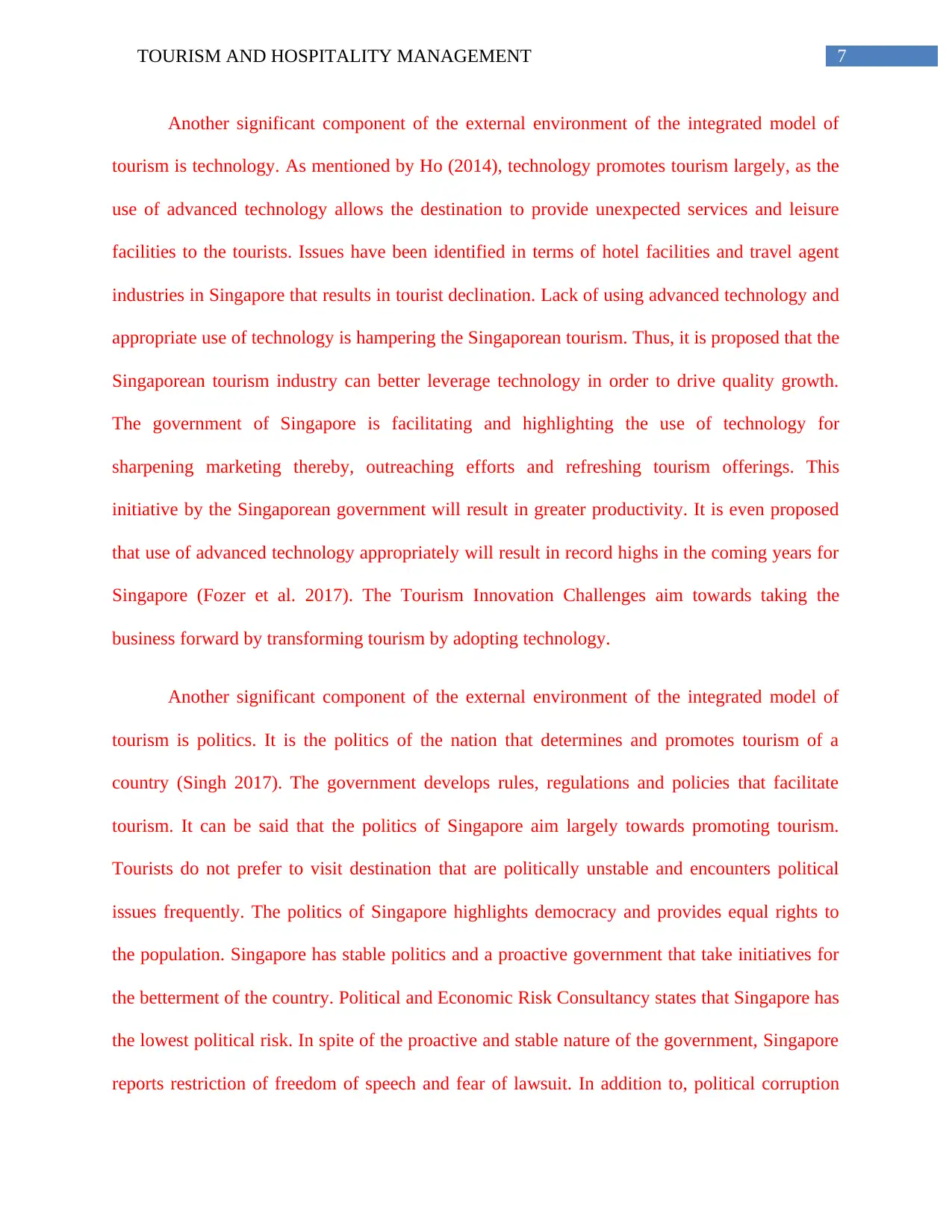
7TOURISM AND HOSPITALITY MANAGEMENT
Another significant component of the external environment of the integrated model of
tourism is technology. As mentioned by Ho (2014), technology promotes tourism largely, as the
use of advanced technology allows the destination to provide unexpected services and leisure
facilities to the tourists. Issues have been identified in terms of hotel facilities and travel agent
industries in Singapore that results in tourist declination. Lack of using advanced technology and
appropriate use of technology is hampering the Singaporean tourism. Thus, it is proposed that the
Singaporean tourism industry can better leverage technology in order to drive quality growth.
The government of Singapore is facilitating and highlighting the use of technology for
sharpening marketing thereby, outreaching efforts and refreshing tourism offerings. This
initiative by the Singaporean government will result in greater productivity. It is even proposed
that use of advanced technology appropriately will result in record highs in the coming years for
Singapore (Fozer et al. 2017). The Tourism Innovation Challenges aim towards taking the
business forward by transforming tourism by adopting technology.
Another significant component of the external environment of the integrated model of
tourism is politics. It is the politics of the nation that determines and promotes tourism of a
country (Singh 2017). The government develops rules, regulations and policies that facilitate
tourism. It can be said that the politics of Singapore aim largely towards promoting tourism.
Tourists do not prefer to visit destination that are politically unstable and encounters political
issues frequently. The politics of Singapore highlights democracy and provides equal rights to
the population. Singapore has stable politics and a proactive government that take initiatives for
the betterment of the country. Political and Economic Risk Consultancy states that Singapore has
the lowest political risk. In spite of the proactive and stable nature of the government, Singapore
reports restriction of freedom of speech and fear of lawsuit. In addition to, political corruption
Another significant component of the external environment of the integrated model of
tourism is technology. As mentioned by Ho (2014), technology promotes tourism largely, as the
use of advanced technology allows the destination to provide unexpected services and leisure
facilities to the tourists. Issues have been identified in terms of hotel facilities and travel agent
industries in Singapore that results in tourist declination. Lack of using advanced technology and
appropriate use of technology is hampering the Singaporean tourism. Thus, it is proposed that the
Singaporean tourism industry can better leverage technology in order to drive quality growth.
The government of Singapore is facilitating and highlighting the use of technology for
sharpening marketing thereby, outreaching efforts and refreshing tourism offerings. This
initiative by the Singaporean government will result in greater productivity. It is even proposed
that use of advanced technology appropriately will result in record highs in the coming years for
Singapore (Fozer et al. 2017). The Tourism Innovation Challenges aim towards taking the
business forward by transforming tourism by adopting technology.
Another significant component of the external environment of the integrated model of
tourism is politics. It is the politics of the nation that determines and promotes tourism of a
country (Singh 2017). The government develops rules, regulations and policies that facilitate
tourism. It can be said that the politics of Singapore aim largely towards promoting tourism.
Tourists do not prefer to visit destination that are politically unstable and encounters political
issues frequently. The politics of Singapore highlights democracy and provides equal rights to
the population. Singapore has stable politics and a proactive government that take initiatives for
the betterment of the country. Political and Economic Risk Consultancy states that Singapore has
the lowest political risk. In spite of the proactive and stable nature of the government, Singapore
reports restriction of freedom of speech and fear of lawsuit. In addition to, political corruption
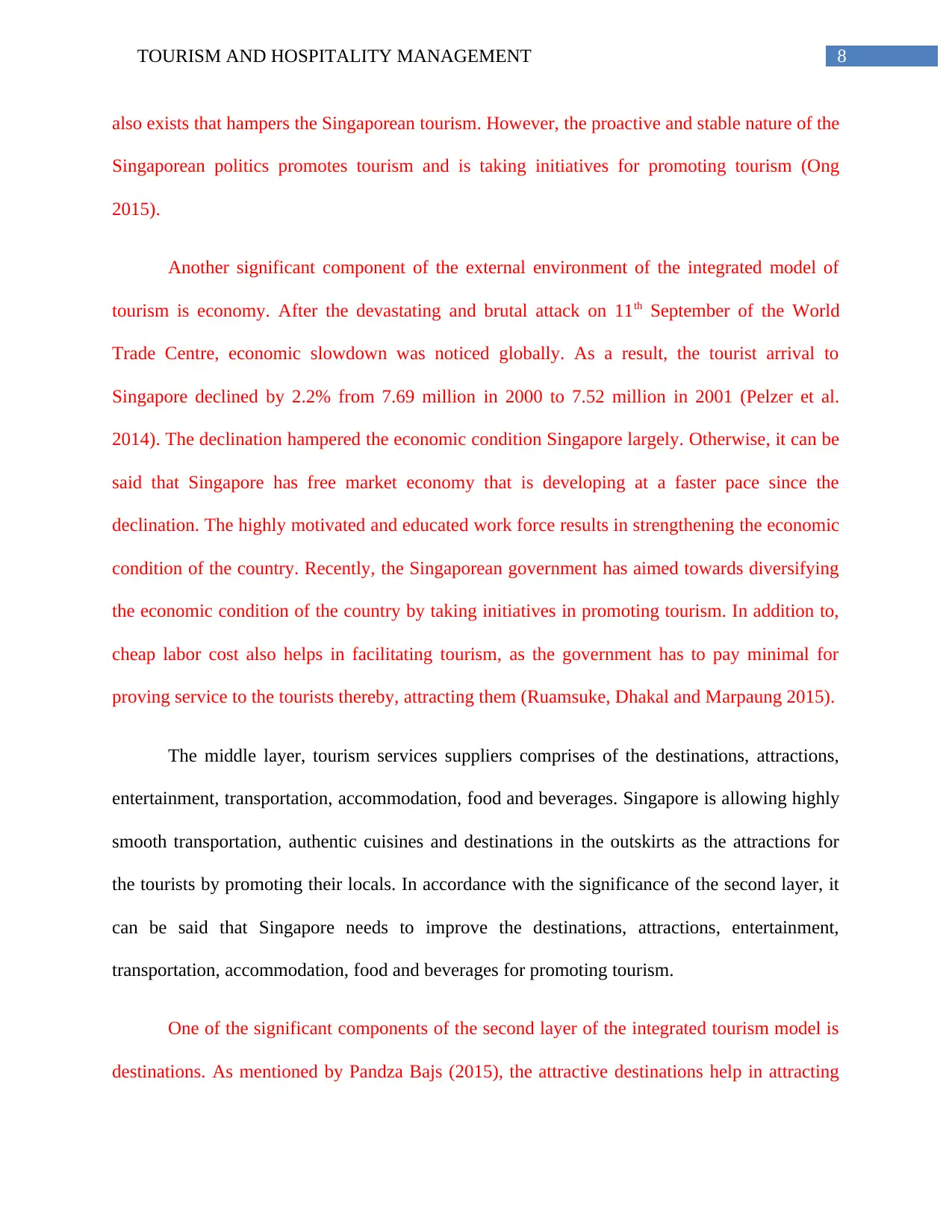
8TOURISM AND HOSPITALITY MANAGEMENT
also exists that hampers the Singaporean tourism. However, the proactive and stable nature of the
Singaporean politics promotes tourism and is taking initiatives for promoting tourism (Ong
2015).
Another significant component of the external environment of the integrated model of
tourism is economy. After the devastating and brutal attack on 11th September of the World
Trade Centre, economic slowdown was noticed globally. As a result, the tourist arrival to
Singapore declined by 2.2% from 7.69 million in 2000 to 7.52 million in 2001 (Pelzer et al.
2014). The declination hampered the economic condition Singapore largely. Otherwise, it can be
said that Singapore has free market economy that is developing at a faster pace since the
declination. The highly motivated and educated work force results in strengthening the economic
condition of the country. Recently, the Singaporean government has aimed towards diversifying
the economic condition of the country by taking initiatives in promoting tourism. In addition to,
cheap labor cost also helps in facilitating tourism, as the government has to pay minimal for
proving service to the tourists thereby, attracting them (Ruamsuke, Dhakal and Marpaung 2015).
The middle layer, tourism services suppliers comprises of the destinations, attractions,
entertainment, transportation, accommodation, food and beverages. Singapore is allowing highly
smooth transportation, authentic cuisines and destinations in the outskirts as the attractions for
the tourists by promoting their locals. In accordance with the significance of the second layer, it
can be said that Singapore needs to improve the destinations, attractions, entertainment,
transportation, accommodation, food and beverages for promoting tourism.
One of the significant components of the second layer of the integrated tourism model is
destinations. As mentioned by Pandza Bajs (2015), the attractive destinations help in attracting
also exists that hampers the Singaporean tourism. However, the proactive and stable nature of the
Singaporean politics promotes tourism and is taking initiatives for promoting tourism (Ong
2015).
Another significant component of the external environment of the integrated model of
tourism is economy. After the devastating and brutal attack on 11th September of the World
Trade Centre, economic slowdown was noticed globally. As a result, the tourist arrival to
Singapore declined by 2.2% from 7.69 million in 2000 to 7.52 million in 2001 (Pelzer et al.
2014). The declination hampered the economic condition Singapore largely. Otherwise, it can be
said that Singapore has free market economy that is developing at a faster pace since the
declination. The highly motivated and educated work force results in strengthening the economic
condition of the country. Recently, the Singaporean government has aimed towards diversifying
the economic condition of the country by taking initiatives in promoting tourism. In addition to,
cheap labor cost also helps in facilitating tourism, as the government has to pay minimal for
proving service to the tourists thereby, attracting them (Ruamsuke, Dhakal and Marpaung 2015).
The middle layer, tourism services suppliers comprises of the destinations, attractions,
entertainment, transportation, accommodation, food and beverages. Singapore is allowing highly
smooth transportation, authentic cuisines and destinations in the outskirts as the attractions for
the tourists by promoting their locals. In accordance with the significance of the second layer, it
can be said that Singapore needs to improve the destinations, attractions, entertainment,
transportation, accommodation, food and beverages for promoting tourism.
One of the significant components of the second layer of the integrated tourism model is
destinations. As mentioned by Pandza Bajs (2015), the attractive destinations help in attracting
⊘ This is a preview!⊘
Do you want full access?
Subscribe today to unlock all pages.

Trusted by 1+ million students worldwide
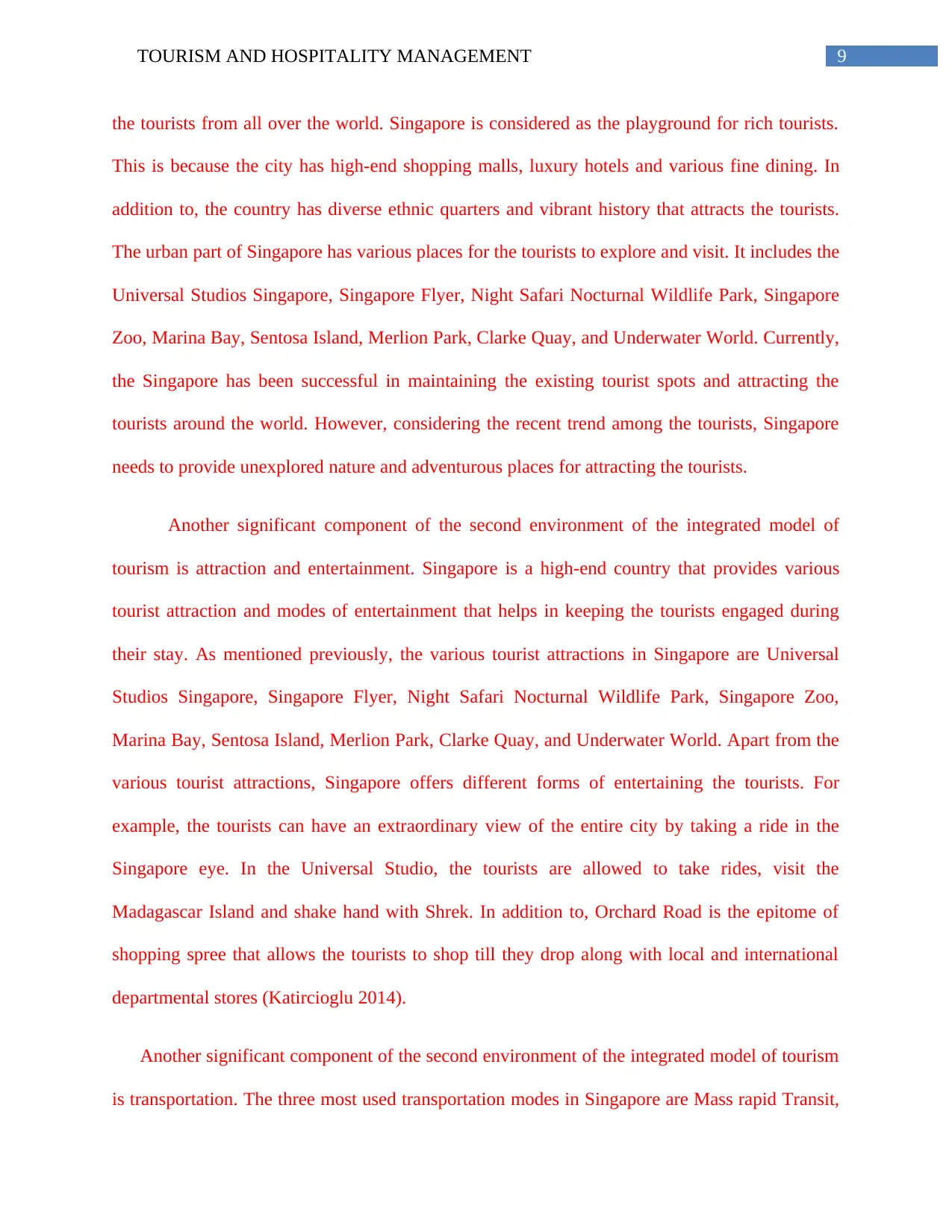
9TOURISM AND HOSPITALITY MANAGEMENT
the tourists from all over the world. Singapore is considered as the playground for rich tourists.
This is because the city has high-end shopping malls, luxury hotels and various fine dining. In
addition to, the country has diverse ethnic quarters and vibrant history that attracts the tourists.
The urban part of Singapore has various places for the tourists to explore and visit. It includes the
Universal Studios Singapore, Singapore Flyer, Night Safari Nocturnal Wildlife Park, Singapore
Zoo, Marina Bay, Sentosa Island, Merlion Park, Clarke Quay, and Underwater World. Currently,
the Singapore has been successful in maintaining the existing tourist spots and attracting the
tourists around the world. However, considering the recent trend among the tourists, Singapore
needs to provide unexplored nature and adventurous places for attracting the tourists.
Another significant component of the second environment of the integrated model of
tourism is attraction and entertainment. Singapore is a high-end country that provides various
tourist attraction and modes of entertainment that helps in keeping the tourists engaged during
their stay. As mentioned previously, the various tourist attractions in Singapore are Universal
Studios Singapore, Singapore Flyer, Night Safari Nocturnal Wildlife Park, Singapore Zoo,
Marina Bay, Sentosa Island, Merlion Park, Clarke Quay, and Underwater World. Apart from the
various tourist attractions, Singapore offers different forms of entertaining the tourists. For
example, the tourists can have an extraordinary view of the entire city by taking a ride in the
Singapore eye. In the Universal Studio, the tourists are allowed to take rides, visit the
Madagascar Island and shake hand with Shrek. In addition to, Orchard Road is the epitome of
shopping spree that allows the tourists to shop till they drop along with local and international
departmental stores (Katircioglu 2014).
Another significant component of the second environment of the integrated model of tourism
is transportation. The three most used transportation modes in Singapore are Mass rapid Transit,
the tourists from all over the world. Singapore is considered as the playground for rich tourists.
This is because the city has high-end shopping malls, luxury hotels and various fine dining. In
addition to, the country has diverse ethnic quarters and vibrant history that attracts the tourists.
The urban part of Singapore has various places for the tourists to explore and visit. It includes the
Universal Studios Singapore, Singapore Flyer, Night Safari Nocturnal Wildlife Park, Singapore
Zoo, Marina Bay, Sentosa Island, Merlion Park, Clarke Quay, and Underwater World. Currently,
the Singapore has been successful in maintaining the existing tourist spots and attracting the
tourists around the world. However, considering the recent trend among the tourists, Singapore
needs to provide unexplored nature and adventurous places for attracting the tourists.
Another significant component of the second environment of the integrated model of
tourism is attraction and entertainment. Singapore is a high-end country that provides various
tourist attraction and modes of entertainment that helps in keeping the tourists engaged during
their stay. As mentioned previously, the various tourist attractions in Singapore are Universal
Studios Singapore, Singapore Flyer, Night Safari Nocturnal Wildlife Park, Singapore Zoo,
Marina Bay, Sentosa Island, Merlion Park, Clarke Quay, and Underwater World. Apart from the
various tourist attractions, Singapore offers different forms of entertaining the tourists. For
example, the tourists can have an extraordinary view of the entire city by taking a ride in the
Singapore eye. In the Universal Studio, the tourists are allowed to take rides, visit the
Madagascar Island and shake hand with Shrek. In addition to, Orchard Road is the epitome of
shopping spree that allows the tourists to shop till they drop along with local and international
departmental stores (Katircioglu 2014).
Another significant component of the second environment of the integrated model of tourism
is transportation. The three most used transportation modes in Singapore are Mass rapid Transit,
Paraphrase This Document
Need a fresh take? Get an instant paraphrase of this document with our AI Paraphraser
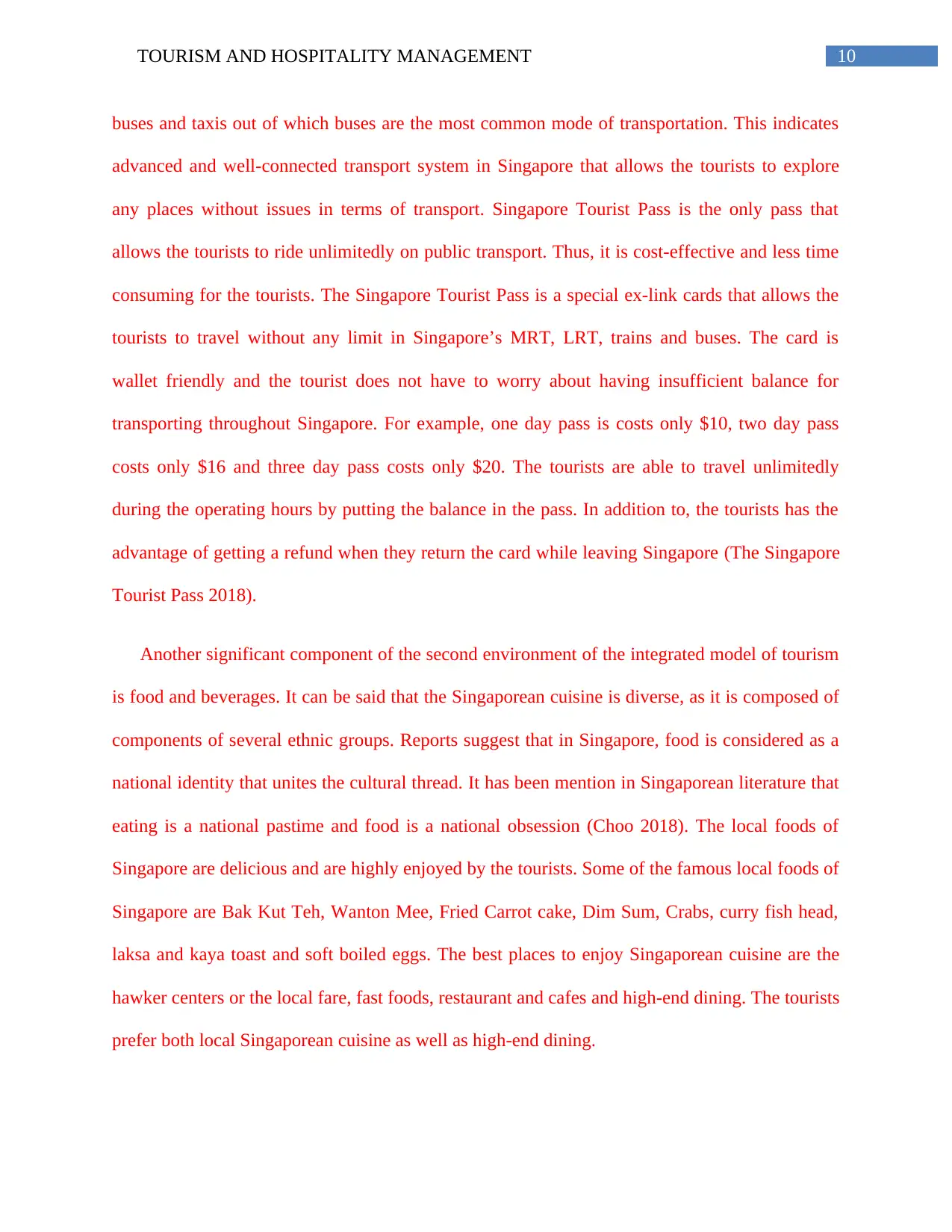
10TOURISM AND HOSPITALITY MANAGEMENT
buses and taxis out of which buses are the most common mode of transportation. This indicates
advanced and well-connected transport system in Singapore that allows the tourists to explore
any places without issues in terms of transport. Singapore Tourist Pass is the only pass that
allows the tourists to ride unlimitedly on public transport. Thus, it is cost-effective and less time
consuming for the tourists. The Singapore Tourist Pass is a special ex-link cards that allows the
tourists to travel without any limit in Singapore’s MRT, LRT, trains and buses. The card is
wallet friendly and the tourist does not have to worry about having insufficient balance for
transporting throughout Singapore. For example, one day pass is costs only $10, two day pass
costs only $16 and three day pass costs only $20. The tourists are able to travel unlimitedly
during the operating hours by putting the balance in the pass. In addition to, the tourists has the
advantage of getting a refund when they return the card while leaving Singapore (The Singapore
Tourist Pass 2018).
Another significant component of the second environment of the integrated model of tourism
is food and beverages. It can be said that the Singaporean cuisine is diverse, as it is composed of
components of several ethnic groups. Reports suggest that in Singapore, food is considered as a
national identity that unites the cultural thread. It has been mention in Singaporean literature that
eating is a national pastime and food is a national obsession (Choo 2018). The local foods of
Singapore are delicious and are highly enjoyed by the tourists. Some of the famous local foods of
Singapore are Bak Kut Teh, Wanton Mee, Fried Carrot cake, Dim Sum, Crabs, curry fish head,
laksa and kaya toast and soft boiled eggs. The best places to enjoy Singaporean cuisine are the
hawker centers or the local fare, fast foods, restaurant and cafes and high-end dining. The tourists
prefer both local Singaporean cuisine as well as high-end dining.
buses and taxis out of which buses are the most common mode of transportation. This indicates
advanced and well-connected transport system in Singapore that allows the tourists to explore
any places without issues in terms of transport. Singapore Tourist Pass is the only pass that
allows the tourists to ride unlimitedly on public transport. Thus, it is cost-effective and less time
consuming for the tourists. The Singapore Tourist Pass is a special ex-link cards that allows the
tourists to travel without any limit in Singapore’s MRT, LRT, trains and buses. The card is
wallet friendly and the tourist does not have to worry about having insufficient balance for
transporting throughout Singapore. For example, one day pass is costs only $10, two day pass
costs only $16 and three day pass costs only $20. The tourists are able to travel unlimitedly
during the operating hours by putting the balance in the pass. In addition to, the tourists has the
advantage of getting a refund when they return the card while leaving Singapore (The Singapore
Tourist Pass 2018).
Another significant component of the second environment of the integrated model of tourism
is food and beverages. It can be said that the Singaporean cuisine is diverse, as it is composed of
components of several ethnic groups. Reports suggest that in Singapore, food is considered as a
national identity that unites the cultural thread. It has been mention in Singaporean literature that
eating is a national pastime and food is a national obsession (Choo 2018). The local foods of
Singapore are delicious and are highly enjoyed by the tourists. Some of the famous local foods of
Singapore are Bak Kut Teh, Wanton Mee, Fried Carrot cake, Dim Sum, Crabs, curry fish head,
laksa and kaya toast and soft boiled eggs. The best places to enjoy Singaporean cuisine are the
hawker centers or the local fare, fast foods, restaurant and cafes and high-end dining. The tourists
prefer both local Singaporean cuisine as well as high-end dining.
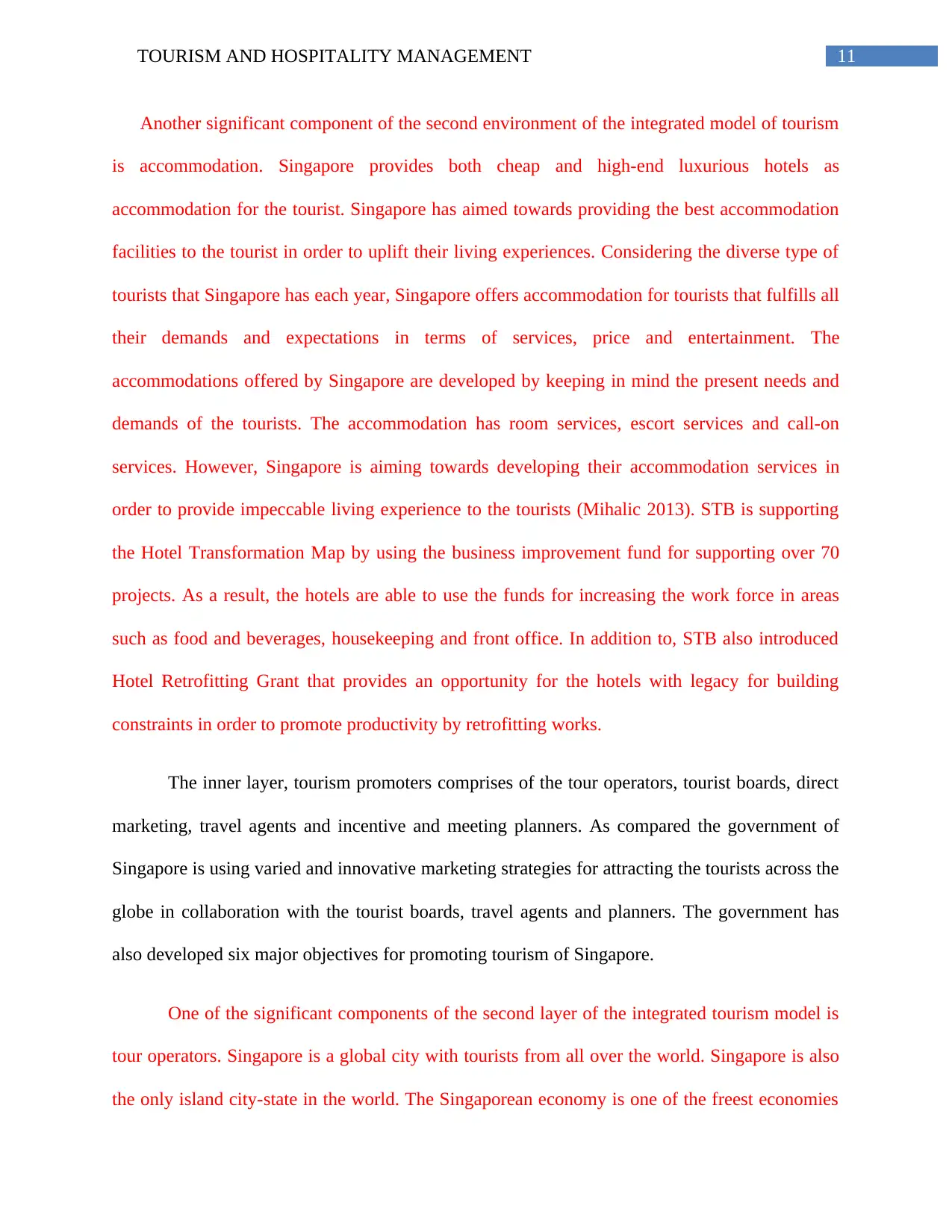
11TOURISM AND HOSPITALITY MANAGEMENT
Another significant component of the second environment of the integrated model of tourism
is accommodation. Singapore provides both cheap and high-end luxurious hotels as
accommodation for the tourist. Singapore has aimed towards providing the best accommodation
facilities to the tourist in order to uplift their living experiences. Considering the diverse type of
tourists that Singapore has each year, Singapore offers accommodation for tourists that fulfills all
their demands and expectations in terms of services, price and entertainment. The
accommodations offered by Singapore are developed by keeping in mind the present needs and
demands of the tourists. The accommodation has room services, escort services and call-on
services. However, Singapore is aiming towards developing their accommodation services in
order to provide impeccable living experience to the tourists (Mihalic 2013). STB is supporting
the Hotel Transformation Map by using the business improvement fund for supporting over 70
projects. As a result, the hotels are able to use the funds for increasing the work force in areas
such as food and beverages, housekeeping and front office. In addition to, STB also introduced
Hotel Retrofitting Grant that provides an opportunity for the hotels with legacy for building
constraints in order to promote productivity by retrofitting works.
The inner layer, tourism promoters comprises of the tour operators, tourist boards, direct
marketing, travel agents and incentive and meeting planners. As compared the government of
Singapore is using varied and innovative marketing strategies for attracting the tourists across the
globe in collaboration with the tourist boards, travel agents and planners. The government has
also developed six major objectives for promoting tourism of Singapore.
One of the significant components of the second layer of the integrated tourism model is
tour operators. Singapore is a global city with tourists from all over the world. Singapore is also
the only island city-state in the world. The Singaporean economy is one of the freest economies
Another significant component of the second environment of the integrated model of tourism
is accommodation. Singapore provides both cheap and high-end luxurious hotels as
accommodation for the tourist. Singapore has aimed towards providing the best accommodation
facilities to the tourist in order to uplift their living experiences. Considering the diverse type of
tourists that Singapore has each year, Singapore offers accommodation for tourists that fulfills all
their demands and expectations in terms of services, price and entertainment. The
accommodations offered by Singapore are developed by keeping in mind the present needs and
demands of the tourists. The accommodation has room services, escort services and call-on
services. However, Singapore is aiming towards developing their accommodation services in
order to provide impeccable living experience to the tourists (Mihalic 2013). STB is supporting
the Hotel Transformation Map by using the business improvement fund for supporting over 70
projects. As a result, the hotels are able to use the funds for increasing the work force in areas
such as food and beverages, housekeeping and front office. In addition to, STB also introduced
Hotel Retrofitting Grant that provides an opportunity for the hotels with legacy for building
constraints in order to promote productivity by retrofitting works.
The inner layer, tourism promoters comprises of the tour operators, tourist boards, direct
marketing, travel agents and incentive and meeting planners. As compared the government of
Singapore is using varied and innovative marketing strategies for attracting the tourists across the
globe in collaboration with the tourist boards, travel agents and planners. The government has
also developed six major objectives for promoting tourism of Singapore.
One of the significant components of the second layer of the integrated tourism model is
tour operators. Singapore is a global city with tourists from all over the world. Singapore is also
the only island city-state in the world. The Singaporean economy is one of the freest economies
⊘ This is a preview!⊘
Do you want full access?
Subscribe today to unlock all pages.

Trusted by 1+ million students worldwide
1 out of 36
Related Documents
Your All-in-One AI-Powered Toolkit for Academic Success.
+13062052269
info@desklib.com
Available 24*7 on WhatsApp / Email
![[object Object]](/_next/static/media/star-bottom.7253800d.svg)
Unlock your academic potential
Copyright © 2020–2025 A2Z Services. All Rights Reserved. Developed and managed by ZUCOL.





